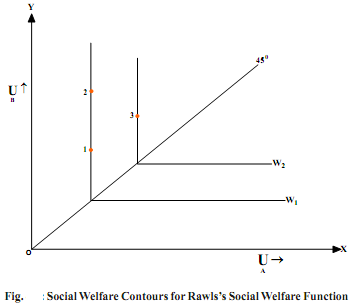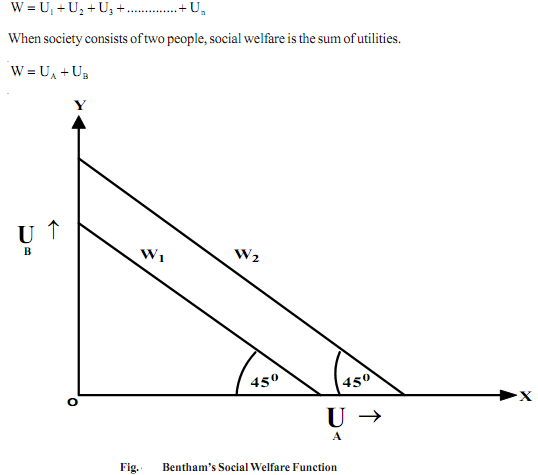Rawls’s and Bentham’s Social Welfare Functions:
Rawls's conception of social welfare function is of the form Wmax = (min U). It implies that the society should identify a person who gets minimum utility and then maximize this person's utility, and having done this, the society should repeat the process consecutively through the population. The philosopher John Rawls in his book A Theory of Justice (1971) proposed that people would want to choose a social welfare that focuses on improving the well being of the poorest or most unfortunate person in the society. Figure shows the social welfare contours implied by Rawls's social welfare function. The social welfare contours are at right angles to the 45o line.

A move from point 1 to 2 does not change social welfare because the utility of better off persons B increases but there is no change in the utility of less well off person A. Yet this change is Pareto improvement because person B is made better off and person A is not worse off. Pareto improvement can therefore occur but Rawls's social welfare function recognizes no social improvement if better off is not the 'weakest link' in the society. Social welfare increases as the consequence of a change from point 1 to point 3 in figure 4.5 because this change increases the utility of weakest link person A.
An alternative approach to defining social welfare is associated with the English Political Economist Jeremy Bentham (1748-1832). Bentham proposed that a society should follow the objective of seeking "the greatest good for the greatest number". The social objective has been interpreted as implying that social welfare is defined by adding the utilities of everybody in society though strictly speaking; it is not correct. For, n people in a society the social welfare function is, therefore,

In Figure the straight lines with slopes of 45o indicate perfect substitutability in social welfare between the utility of one person and the utility of another. All that matter for social welfare is the sum of utilities. The distribution of utilities does not matter. Rawls and Bentham are limiting cases of a general social welfare function. Rawls care only about distribution and only about the worst person. Bentham is indifferent to distribution and wants the sum of utilities to be maximized without regard for distribution.